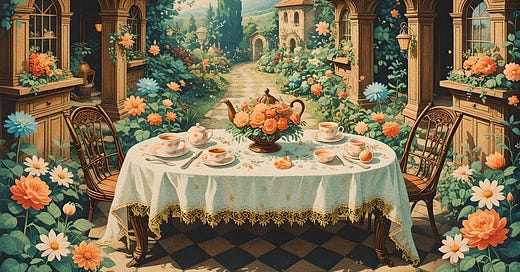Thread 008: The Art of Building Worlds at Scale
On community architecture, the poetry of belonging, and finding beauty in digital spaces...
There's a particular quality to connection when it happens across digital space—a warmth that transcends the cool glow of screens. In my first few weeks at Blaze, I've witnessed this phenomenon unfold in our growing community. New members introduce themselves with a mixture of vulnerability and hope. Entrepreneurs share their journeys, not just their successes but their struggles too. Someone celebrates a small milestone, and within moments, strangers become cheerleaders, offering genuine encouragement that feels as real as any physical embrace.
What strikes me most is the resilience that pulses through these interactions. Business owners facing the same headwinds find solidarity in shared challenges. They exchange resources generously—a tip about a feature they discovered, a workflow that saved them hours, a perspective that shifted their approach. In these exchanges, I recognize something profound: community forming not despite digital distance, but within it, turning pixelated interfaces into spaces of genuine human connection.
I observe these interactions with a mixture of wonder and recognition. Though no wine glasses clink and no candles flicker, I see the unmistakable energy of salon culture blooming in digital space.
The parallels are striking. In 18th century Paris, salons hosted by women like Madame Geoffrin would gather philosophers, artists, and scientists under one roof, creating the conversational alchemy that fueled the Enlightenment. In Harlem during the 1920s, house parties hosted by A'Lelia Walker brought together writers, musicians, and intellectuals whose collective energy sparked a cultural renaissance. The Greek agoras, the coffeehouses of Enlightenment London, the artistic communes of 1960s San Francisco—throughout history, humanity has created physical spaces where ideas could comingle, where unlikely connections could form, where individual sparks could ignite collective fires.
This digital gathering space I now help nurture at Blaze is simply the newest incarnation of this ancient human tradition. The medium has changed, but the fundamental hunger for connection, for exchange, for the particular magic that happens when different minds encounter each other in thoughtfully designed space—this remains constant.
What fascinates me is how my years of brand worldbuilding have prepared me for this work in ways I never anticipated. Both require the same fundamental understanding: that worlds aren't built through features or functions, but through feeling. Whether designing a client's brand ecosystem or mapping the architecture of a digital community, the essential question remains: "How do we want people to feel when they enter this space?"
In my Brand Tea Party workshops, I guide clients through creating immersive brand experiences that draw people in naturally. We map emotional journeys, design narrative touchpoints, craft spaces where their audience can become active participants rather than passive consumers. This language of worldbuilding—of crafting environments that evoke specific emotions, that invite participation, that create a sense of belonging—translates seamlessly to community architecture.
The platforms change, the technologies evolve, but the human need to feel seen, to contribute, to belong—this remains unchanged since our ancestors gathered around the first fires.
There's poetry in this work that few might recognize from the outside. Designing conversation prompts that encourage vulnerability. Creating spaces for celebration that transform individual wins into collective joy. Mapping digital "neighborhoods" where certain types of exchanges can flourish. These aren't just strategic decisions; they're acts of creation as deliberate as any sonnet, as nuanced as any brushstroke.
I think about the weight of certain words in community spaces—welcome, gather, share, celebrate. How these simple verbs can transform a collection of individuals into something more cohesive, more alive. There's an art to knowing when to guide and when to step back, when to structure and when to allow organic growth, when to amplify certain voices and when to create space for quieter ones to emerge.
This balance between structure and emergence reminds me of Toni Morrison's reflections on community in her novel "Paradise." She writes about the tension between the desire for order and the necessity of openness, between preservation and evolution. "They think they have outfoxed the whiteman when in fact they imitate him," she writes of a community that becomes so focused on boundaries and rules that it loses its soul. In my work, I carry this caution—that communities require both architecture and breathing room, both common purpose and space for divergence.
I find myself drawing unexpected inspiration from Italo Calvino's "Invisible Cities," where he imagines fantastical urban landscapes that exist as much in the mind as in physical space. "Cities, like dreams, are made of desires and fears," he writes. Digital communities follow this same truth—they are constructed not just of code and interfaces but of the collective desires and fears of their members. Understanding these emotional currents is as essential to community building as understanding the technical architecture.
What amazes me is how this work at scale is informing my vision for more intimate gatherings like Casa Saqi. I notice how certain patterns of mutual support that emerge organically online can be intentionally cultivated around a dinner table. How rituals of welcome that make newcomers feel seen in digital space can be adapted for physical gatherings. How the careful balance of structure and spontaneity that keeps online communities vibrant applies equally to salon gatherings in Barcelona courtyards or Mallorcan cliffside terraces.
There's a French term, "mise en place," used by chefs to describe the careful arrangement of ingredients and tools before cooking begins. Building digital communities requires its own form of mise en place—a thoughtful preparation of elements that will later combine in ways we can guide but never fully predict. Like preparing for a Casa Saqi gathering, I consider what "ingredients" need to be adjacent, what conversations might spark from certain juxtapositions, what spaces need to be created for both planned and spontaneous interactions.
The scale may differ drastically between a global digital community and an intimate dinner gathering, but the fundamental principles remain: create spaces where people feel both safe and inspired, where boundaries are clear but possibilities are endless, where individual expression can flourish while collective identity forms.
Some of the most powerful digital communities have evolved from simple platforms into meaningful cultural forces. I think of Archive of Our Own, which began as a place for fan fiction writers to share their work and evolved into a Hugo Award-winning literary community that has transformed how we think about collaborative storytelling and creative ownership. Or Black Twitter, which emerged organically as a space for Black cultural expression and political discourse, eventually influencing mainstream media, pop culture, and activism in profound ways. These spaces weren't just platforms but worlds with their own languages, norms, rituals, and transformative powers.
What makes these digital communities powerful is precisely what makes physical gatherings meaningful: not just the infrastructure, but the culture that emerges within it. Not just the walls (or interfaces), but what happens in the space between them. Not just the invitation, but how welcome people feel once they arrive.
In my work at Blaze, I find myself existing in a space between storyteller and architect, between poet and urban planner. Each day brings opportunities to shape environments where thousands of people will gather, connect, create. This isn't separate from my artistic identity—it's an extension of it, a different canvas for the same fundamental work of creating worlds where people feel they belong.
And isn't that, ultimately, what both Brand Tea Party and Casa Saqi have always been about? Creating spaces—whether conceptual or physical—where belonging feels natural, where transformation happens through connection, where individual stories weave into collective meaning?
The medium changes. The scale shifts. But the essential work remains the same: to create worlds where people can discover parts of themselves they hadn't yet recognized. To design environments where ideas can find fertile soil in which to root and grow. To build spaces where magic happens not through elaborate mechanisms but through the simple alchemy of the right souls gathered in thoughtful proximity.
Whether it's entrepreneurs supporting each other in a digital community or artists gathered around a Barcelona dinner table, the golden thread running through all this work is the same: the creation of worlds where connection happens naturally, where people feel simultaneously free and belonging, where individual sparks combine into collective light.
As I navigate this unexpected but beautiful chapter, I'm discovering that community architecture at scale isn't a detour from my artistic path but an expansion of it. The digital city I'm helping to build at Blaze has become a fourth world in my constellation—existing alongside Barcelona's modernist dreams, Mallorca's ancient wisdom, and Toronto's grounding embrace. Each with its own particular quality of light, its own unique magic, its own lessons to teach about how we create spaces where souls can recognize each other across all kinds of distances.
Perhaps this is what my golden thread has been leading toward all along: not just the creation of a personal life split between beloved cities, but the larger work of building worlds—digital and physical, intimate and vast—where others can find their own golden threads, follow their own winding paths, discover their own unexpected magic.
With warmth and curiosity,
P.S. I wonder about the worlds you're building, whether at the scale of a dinner table or a digital platform or somewhere in between. What spaces are you creating where connection can happen? What elements have you found essential for cultivating belonging? What unexpected magic have you witnessed when you've brought the right souls together in thoughtfully designed proximity? The comments are open, and I read each one with appreciation for your wisdom and experiences.






